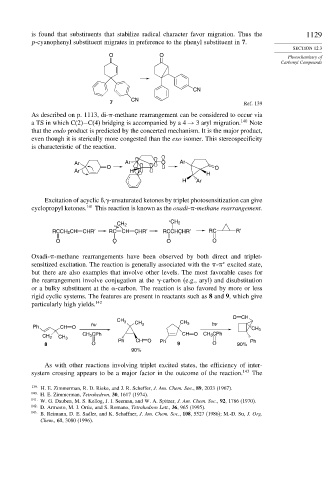Page 1144 - Advanced Organic Chemistry Part A - Structure and Mechanisms, 5th ed (2007) - Carey _ Sundberg
P. 1144
is found that substituents that stabilize radical character favor migration. Thus the 1129
p-cyanophenyl substituent migrates in preference to the phenyl substituent in 7.
SECTION 12.3
O O
Photochemistry of
Carbonyl Compounds
CN
CN
7 Ref. 139
As described on p. 1113, di- -methane rearrangement can be considered to occur via
a TS in which C(2)−C(4) bridging is accompanied by a 4 → 3 aryl migration. 140 Note
that the endo product is predicted by the concerted mechanism. It is the major product,
even though it is sterically more congested than the exo isomer. This stereospecificity
is characteristic of the reaction.
Ar Ar O Ar
O O
Ar H
H
H Ar
Excitation of acyclic ß, -unsaturated ketones by triplet photosensitization can give
cyclopropyl ketones. 141 This reaction is known as the oxadi- -methane rearrangement.
CH 2
CH 2
RCCH 2CH CHR′ RC CH CHR′ RCCHCHR′ RC R′
O O O O
Oxadi- -methane rearrangements have been observed by both direct and triplet-
∗
sensitized excitation. The reaction is generally associated with the - excited state,
but there are also examples that involve other levels. The most favorable cases for
the rearrangement involve conjugation at the -carbon (e.g., aryl) and disubstitution
or a bulky substituent at the -carbon. The reaction is also favored by more or less
rigid cyclic systems. The features are present in reactants such as 8 and 9, which give
particularly high yields. 142
O CH
CH 3 CH
Ph CH O hv 3 CH 3 hv
CH 3
CH 3 CPh CH O CH 3 CPh
CH 3 CH 3
Ph CH O Ph Ph
8 O 9 O 90%
90%
As with other reactions involving triplet excited states, the efficiency of inter-
system crossing appears to be a major factor in the outcome of the reaction. 143 The
139 H. E. Zimmerman, R. D. Rieke, and J. R. Scheffer, J. Am. Chem. Soc., 89, 2033 (1967).
140 H. E. Zimmerman, Tetrahedron, 30, 1617 (1974).
141
W. G. Dauben, M. S. Kellog, J. I. Seeman, and W. A. Spitzer, J. Am. Chem. Soc., 92, 1786 (1970).
142 D. Armesto, M. J. Ortiz, and S. Romano, Tetrahedron Lett., 36, 965 (1995).
143
B. Reimann, D. E. Sadler, and K. Schaffner, J. Am. Chem. Soc., 108, 5527 (1986); M.-D. Su, J. Org.
Chem., 61, 3080 (1996).

